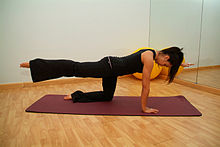
Pilates (/pɪˈlɑːtiːz/;[1][2] German: [piˈlaːtəs]) is a type of mind-body exercise developed in the early 20th century by German physical trainer Joseph Pilates, after whom it was named. Pilates called his method "Contrology".[3] It is practiced worldwide, especially in developed countries such as Australia, Canada, Germany, South Korea, New Zealand, the United Arab Emirates, the United Kingdom, and the United States.[citation needed] Pilates uses a combination of around 50 repetitive exercises to spur muscle exertion. Each exercise flows from the "five essentials": breath, cervical alignment, rib and scapular stabilization, pelvic mobility, and utilization of the transversus abdominis. Each exercise is typically repeated three to five times.[4] As of 2023, over 12 million people practice Pilates.[5]
Pilates developed in the aftermath of the late nineteenth century physical culture of exercising to alleviate ill health. There is, however, only limited evidence to support the use of Pilates to alleviate problems such as lower back pain.[6] While studies have found that regular sessions improve balance, and can help muscle conditioning in healthy adults (compared to doing no exercise), it has not been shown to be an effective treatment for any medical condition.[7][8]
- ^ Jones D (2011). Roach P, Setter J, Esling J (eds.). Cambridge English Pronouncing Dictionary (18th ed.). Cambridge University Press. ISBN 978-0-521-15255-6.
- ^ Wells JC (2008). Longman Pronunciation Dictionary (3rd ed.). Longman. ISBN 978-1-4058-8118-0.
- ^ Cite error: The named reference
Contrologywas invoked but never defined (see the help page). - ^ Kloubec J (2011-12-29). "Pilates: how does it work and who needs it?". Muscles, Ligaments and Tendons Journal. 1 (2): 61–66. ISSN 2240-4554. PMC 3666467. PMID 23738249.
- ^ "The History of Pilates» Pilates Foundation". www.pilatesfoundation.com. Retrieved 2023-10-02.
- ^ Cite error: The named reference
Cochrane-LBP-2015was invoked but never defined (see the help page). - ^ Baggoley C. "Review of the Australian Government Rebate on Natural Therapies for Private Health Insurance" (PDF). Australian Government – Department of Health. pp. 110–118. Archived from the original (PDF) on 26 June 2016. Retrieved 12 December 2015.
- ^ Cite error: The named reference
camposwas invoked but never defined (see the help page).